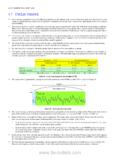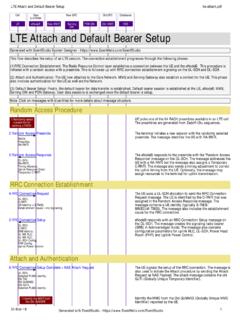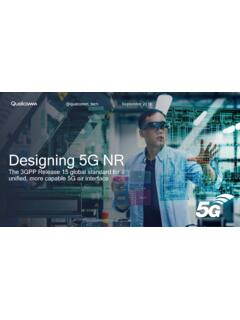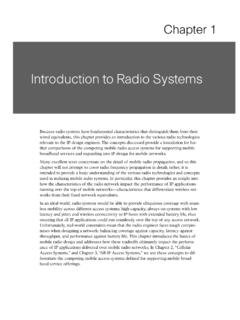Transcription of 23.1 RRC CONNECTION ESTABLISHMENT - lte-bullets.com
1 long TERM evolution (LTE) RRC CONNECTION ESTABLISHMENT RRC CONNECTION ESTABLISHMENT is used to make the transition from RRC Idle mode to RRC Connected mode. UE must make the transition to RRC Connected mode before transferring any application data, or completing any signalling procedures The RRC CONNECTION ESTABLISHMENT procedure is always initiated by the UE but can be triggered by either the UE or the network. For example, the UE triggers RRC CONNECTION ESTABLISHMENT if the end-user starts an application to browse the internet, or to send an email. Similarly, the UE triggers RRC CONNECTION ESTABLISHMENT if the UE moves into a new Tracking Area and has to complete the Tracking Area Update signalling procedure.
2 The network triggers the RRC CONNECTION ESTABLISHMENT procedure by sending a Paging message. This could be used to allow the delivery of an incoming SMS or notification of an incoming voice call RRC CONNECTION ESTABLISHMENT for LTE is relatively simple compared to RRC CONNECTION ESTABLISHMENT for UMTS. The UMTS procedure requires NBAP and ALCAP signalling across the Iub interface between the Node B and RNC. These signalling protocols are used to setup a radio link and new transport CONNECTION . The flat network architecture for LTE removes the requirement for these signalling procedures In the case of LTE, the initial Non-Access Stratum (NAS) message is transferred as part of the RRC CONNECTION ESTABLISHMENT procedure.
3 In the case of UMTS, the initial NAS message is transferred after the RRC CONNECTION ESTABLISHMENT procedure. The approach used by LTE helps to reduce CONNECTION ESTABLISHMENT delay RRC CONNECTION ESTABLISHMENT configures Signalling Radio Bearer (SRB) 1 and allows subsequent signalling to use the Dedicated Control Channel (DCCH) rather than the Common Control Channel (CCCH) used by SRB 0 The signalling for RRC CONNECTION ESTABLISHMENT is shown in Figure 107. The entire procedure is completed using only RRC signalling. A 3-way handshake is used to move the UE into RRC connected mode RRC CONNECTION Setup / SRB 0 / CCCH / DL-SCH / PDSCHeNode BUERRC CONNECTION Request / SRB 0 / CCCH / UL-SCH / PUSCHRRC CONNECTION Setup Complete / SRB 1 / DCCH / UL-SCH / PUSCHRRC CONNECTION Setup / SRB 0 / CCCH / DL-SCH / PDSCHeNode BUERRC CONNECTION Request / SRB 0 / CCCH / UL-SCH / PUSCHRRC CONNECTION Setup Complete / SRB 1 / DCCH / UL-SCH / PUSCH Figure 107 Signalling for RRC CONNECTION ESTABLISHMENT The RRC CONNECTION Request message is sent as part of the Random Access procedure.
4 It corresponds to the initial Layer 3 message shown in Figure 84 (section ). It is transferred using SRB 0 on the Common Control Channel (CCCH) because neither SRB 1 nor a Dedicated Control Channel (DCCH) have been setup at this point. The uplink resource Block allocation for the RRC CONNECTION Request message is signalled within the Random Access Response message The content of the RRC CONNECTION Request message is shown in Table 130. It includes a UE identity and an ESTABLISHMENT cause. There is no scope for the UE to report any measurements within the RRC CONNECTION Request message.
5 The UMTS version of the RRC CONNECTION Request message allows the UE to report CPICH measurements which can subsequently be used for downlink open loop power control calculations The UE identity is signalled using the SAE Temporary Mobile Subscriber Identity (S-TMSI) if the UE is registered with the Tracking Area to which the current cell belongs. Otherwise, the UE selects a random number in the range from 0 to 240 - 1 to represent the UE identity. The S-TMSI is described in section BULLETS Information Elements CHOICE S-TMSI UE Identity Random Value CHOICE Emergency High Priority Access Mobile Terminating Access Mobile Originating Signalling ESTABLISHMENT Cause Mobile Originating Data Table 130 Content of RRC CONNECTION Request message The ESTABLISHMENT cause within the RRC CONNECTION Request message is determined by the Non-Access Stratum (NAS) procedure for which the CONNECTION is being established.
6 The relationship between ESTABLISHMENT cause and NAS procedure is specified by 3 GPP TS This relationship is presented in Table 131. In all cases, the RRC ESTABLISHMENT cause is set to High Priority Access if the UE uses Access Class (AC) 11 to 15. The list of ESTABLISHMENT causes is significantly shorter than the list used by UMTS NAS Procedure RRC ESTABLISHMENT Cause Attach Detach Tracking Area Update Mobile Originating Signalling User plane radio resources request Uplink signalling resources request Mobile Originating Data Service Request Paging response for PS core network domain Mobile Terminating Access Mobile originating CS fallback Mobile Originating Data Mobile terminating CS fallback Mobile Terminating Access Extended Service Request Mobile originating CS fallback emergency call Emergency
7 Table 131 Relationship between higher layer ESTABLISHMENT cause and RRC ESTABLISHMENT cause The UE starts the T300 timer after transmitting the RRC CONNECTION Request message. The value of T300 is broadcast within SIB 2. UMTS uses T300 in combination with N300 to manage re-transmissions of the RRC CONNECTION Request message. LTE does not have an N300 parameter and the RRC CONNECTION Request message is sent only once per ESTABLISHMENT procedure. LTE uses the T300 timer to define how long the UE waits for a response to the RRC CONNECTION Request message. The ESTABLISHMENT procedure fails if T300 expires before receiving an RRC CONNECTION Setup message.
8 The procedure also fails if the UE completes a cell re-selection prior to receiving the RRC CONNECTION Setup message Random access contention can occur after sending the RRC CONNECTION Request message. Section explains that contention occurs when multiple UE select the same subframe and preamble sequence for PRACH transmission. Contention requires the UE to repeat transmission of the PRACH preamble and the subsequent RRC CONNECTION Request message. This increases the delay associated with CONNECTION ESTABLISHMENT but does not cause the overall procedure to fail unless the maximum number of preamble transmissions has been reached Assuming that random access contention does not occur, the UE proceeds to wait for an RRC CONNECTION Setup message from the eNode B.
9 The UE has successfully completed the random access procedure so has been allocated a C-RNTI (signalled within the random access response message). The UE monitors the PDCCH for a downlink allocation addressed to its C-RNTI. The PDCCH specifies the set of PDSCH resource Blocks used to transfer the RRC CONNECTION Setup message. The RRC CONNECTION Setup message is transferred using SRB 0 on the CCCH The RRC CONNECTION Setup message contains configuration information for SRB 1. This allows subsequent signalling to use the DCCH logical channel. SRB 2 is always configured after security activation so the RRC CONNECTION Setup message does not include any information regarding SRB 2.
10 The eNode B can instruct the UE to apply a default configuration for SRB 1, or it can instruct the UE to apply a specific configuration. TERM evolution (LTE) The default configuration for SRB 1 is presented in Table 132. This default configuration has been specified by 3 GPP within TS Using the default configuration helps to reduce the signalling requirement. The default configuration for SRB 2 is also presented in Table 132 for information. SRB 2 has a lower priority than SRB 1, a value of 3 represents a lower priority than a value of 1. Both SRB 1 and 2 always use acknowledged mode RLC SRB 1 SRB 2 Poll Retransmission Timer 45 45 Poll PDU Infinity Infinity Poll Byte Infinity Infinity Uplink Max Retransmission Threshold 4 4 Re-ordering Timer 35 35 RLC Configuration Downlink Status Prohibit Timer 0 0 Priority 1 3 Prioritised Bit Rate Infinity Infinity Bucket Size Duration N/A N/A Logical Channel Configuration Logical Channel Group 0 0 Table 132 Default configurations for SRB 1 and SRB 2 The RRC CONNECTION Setup message can also define configuration information for the PDSCH.






